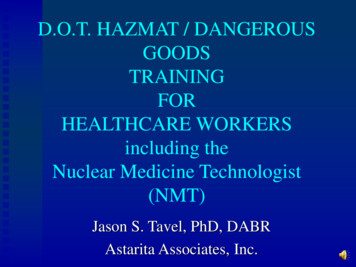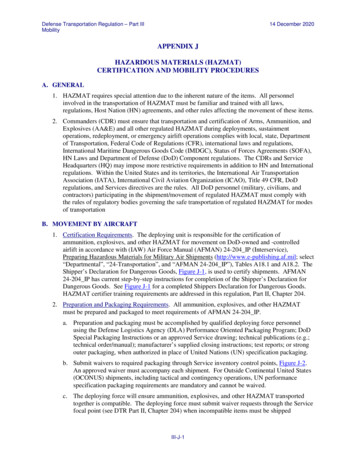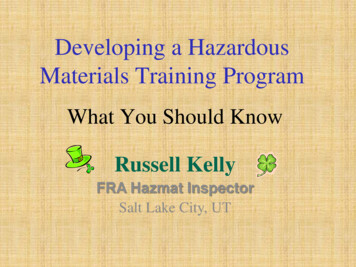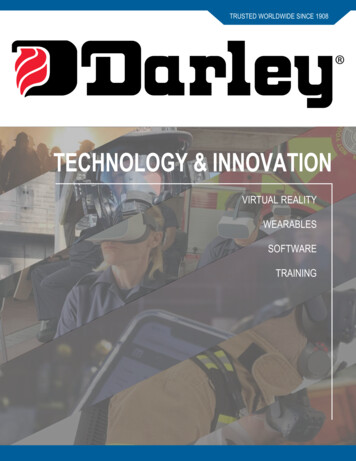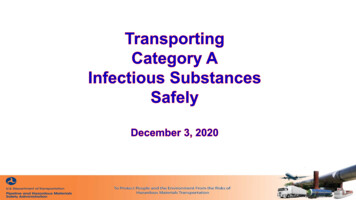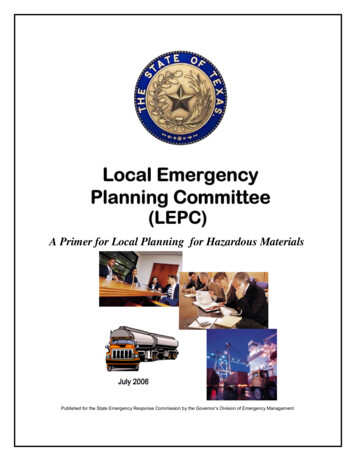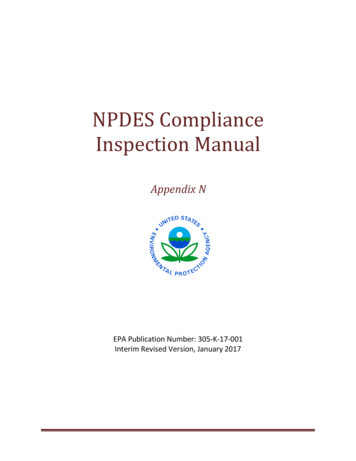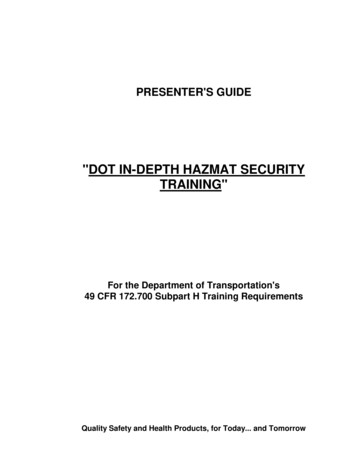
Transcription
PRESENTER'S GUIDE"DOT IN-DEPTH HAZMAT SECURITYTRAINING"For the Department of Transportation's49 CFR 172.700 Subpart H Training RequirementsQuality Safety and Health Products, for Today. and Tomorrow
OUTLINE OF MAJOR PROGRAM POINTS
OUTLINE OF MAJOR PROGRAM POINTSThe following outline summarizes the major points of information presentedin the program. The outline can be used to review the program beforeconducting a classroom session, as well as in preparing to lead a classdiscussion about the program. Each day, millions of tons of hazardous materials aresafely transported, by trucks, trains, planes, ships andpipelines, to facilities throughout the country. But the September 11th tragedy and other terroristincidents that have occurred since then have clearlydemonstrated that we need to protect ourselves everyday from people who would attack us.— In the wrong hands, hazardous materials can be,and have been, used as weapons. From a terrorist's point of view, hazardous materialscan be "the perfect weapon".— Flammable, explosive, corrosive, reactive or toxicto people and the environment, HAZMATs canwork well as "weapons of mass destruction".— And they are often easily available. Unlike military equipment and weapons, HAZMATs arein use, in storage or in transit throughout the UnitedStates every day.— To extremists, this means that the materialsare already located in populated areas, wherethey can be released immediately, by attackson warehouses, industrial facilities, or fromshipments that are being transported.— HAZMATs can be legally purchased or stolenfor use in later attacks, as well. To prevent this, the U.S. Department of Transportation(DOT) has established security regulations which applyto all businesses that are involved in the transportationof hazardous materials.1
The DOT further requires these companies to providetheir employees with two types of training on theseregulations.— "Security Awareness Training"— "In-Depth Security Training". DOT HAZMAT Security Awareness Training must begiven to all workers who load, deliver or otherwiseparticipate in the transportation of any hazardousmaterials. "Awareness" training provides employees with anunderstanding of the security risks that can beassociated with transporting hazardous materials.— It also addresses the policies and proceduresthat should be followed to help the HAZMATsreach their destination safely. Shippers and carriers of certain types and quantitiesof hazardous materials are also required to create theirown written HAZMAT "Security Plan", as well asprovide In-Depth Security Training for their employees. In addition to discussing the goals, organizationand management of their company's Security Plan,"In-Depth" training shows employees how to:— Recognize security threats.— Perform specific security procedures.— Respond to a security breach or attack. DOT In-Depth HAZMAT Security Training helpsemployees like you act as the first line of defenseagainst terrorists using hazardous materials to attackpeople in the U.S.2
To prevent HAZMATs from falling into the hands ofterrorists or other criminals, the DOT requires mostHAZMAT shippers to create and implement a written"Security Plan".— Your company will have such a plan if ittransports certain quantities and types ofhazardous materials, including substancesthat are explosive or radioactive or "selectagents and toxins" that are regulated by theCenters for Disease Control and Prevention. To create a Security Plan the first thing a company willneed to do is conduct a "risk assessment", to identifyspecific hazards that the Plan needs to address.— The assessment determines which of thematerials that are handled by or stored at thefacility could be used by terrorists as "weaponsof mass destruction". The assessment will also examine:— Personnel security, including intentionalor unintentional security breaches that arecaused by employees.— "Unauthorized access", the ways that terroristscould penetrate security and physically get insidea facility.— "En Route Security", how HAZMATs could bestolen or sabotaged while they are in transitbetween facilities. Once these vulnerabilities have been identified, theSecurity Plan can be structured to control or eliminatethem. When the plan is completed, the DOT requires thatemployees:— Receive training on the policies andprocedures that are included in the Plan.— Be provided with the written portions ofthe Plan that apply to the tasks that theyperform in their work at the facility.3
"Personnel security" has a high priority for a goodreason, because employees can compromise acompany's security very easily.— Employees know the physical layout of afacility as well as its security procedures.— As part of their work, employees may alsohave access to "sensitive areas" such asHAZMAT storage locations. One misguided worker or "bad apple" could passon information that puts the Security Plan, and thehazardous materials that it protects, at risk.— This is why the DOT requires all facilities thatdeal with HAZMATs to conduct backgroundchecks on job applicants and employees.— It's important to determine if someone might beinclined to reveal sensitive information, beforethey can do it. Security "spot-checks" of lockers as well as personalvehicles for security violations can also be performedas an additional safeguard.— "Unintentional" security breaches can be just asserious as the ones that are done on purpose. It's important to remember that terrorists have theskills and technology to:— Eavesdrop on you.— Penetrate your company's computer networks.— Hack into the equipment that is connected tothem. To avoid revealing confidential information, sensitivedata should always be encrypted before you store iton a computer or send it across any type of network. Terrorists want to use HAZMATs to help them wagetheir own kind of war against us.4
To prevent criminals from getting hold of hazardousmaterials, you should always be careful of what yousay, how you say it, where you say it (or store it) andwho you say it to.— You should never talk about your facility’soperations in public places or discuss sensitiveinformation over wireless devices such as cellphones. When someone who has no business being inside afacility that handles HAZMATs does manage to get in,the DOT calls it "unauthorized access".— If that person is a terrorist, unauthorized accesscould let them steal or sabotage the hazardousmaterials at the location. The DOT requires companies that handle HAZMATs todescribe how they will prevent unauthorized access totheir facility in their written Security Plan.— A Security Plan can combine the use of physicalbarriers with surveillance systems and standardsecurity procedures. "Physical barriers" typically include walls and fencingaround a facility, which can be further "hardened"against attacks with concrete barricades and perimetertrenches.— Surveillance lights, cameras and security patrolshelp to prevent anyone from sneaking up on thesite without being noticed.— An alarm system can provide visual and audiblewarnings of any would-be intruders that domanage to get too close. Controlling personnel and vehicle access is also veryimportant.— If possible, a facility should have only one,guarded accessway, which should be equippedwith a gate.— All gates and entrance doors into the facilityshould be kept locked.5
All visitors to a site should have to show identificationand sign in before being admitted.— Someone from the company should stay withthem throughout their visit. No delivery vehicle should be allowed inside thefacility's grounds unless:— The shipment is expected.— The driver's name, license and vehicle number"check out".— The shipping papers and other documentationfor the delivery are all in order. Even then, the vehicle and its cargo should still bethoroughly inspected before being allowed throughthe gate. Gates should be closed immediately after a vehiclepasses through, so another vehicle can't sneak inwithout stopping for clearance. Security procedures should continue on the inside ofthe facility as well.— "Sensitive areas" and HAZMAT storage locationsshould be kept locked.— Valves on pipelines, tanks as well as storage vatsshould be secured too. Access to keys should be controlled through an"authorization and sign-out" system.— All security devices such as locks, and cardreaders should be inspected regularly forsigns of tampering. When a HAZMAT shipment leaves a secure facility, itbecomes a much easier target for sabotage, theft orhijacking by terrorists.6
So the DOT requires a company's Security Plan toestablish the infrastructure, policies and proceduresthat are necessary to keep the hazardous materialsthat they ship safe while they are "en route" to theirdestination.— While we are focusing on HAZMATs that aretraveling by truck, many of the security principlesand practices that are described here will apply toother forms of transportation as well. A company that ships hazardous materials by truckshould establish a "crisis communication system" forall its delivery vehicles. Radio and other wireless communications allowvehicle operators to:— Stay in touch with their home terminal.— Report problems in real time.— Contact emergency services or local lawenforcement quickly if they need to. Many HAZMAT shippers also use GPS technology tomonitor their vehicles.— GPS can alert dispatchers when a hijacking isin progress, and help law enforcement locatethe stolen vehicle, as well. Routine HAZMAT deliveries can become a greatersecurity risk if a truck always follows the same routeto get to its destinations, and always arrives at thesame times.— Varying delivery schedules and routes will makeit more difficult for criminals to plan a hijacking,and should be done whenever possible. Companies should also schedule several smallerdeliveries of hazardous materials, rather than havingone big one.— This limits the quantity of a material that can bestolen and makes it less likely that a single loadcould be used as a "weapon of mass destruction".7
It's also important to have reliable people behind thewheel of the delivery vehicles.— Before commercial drivers are allowed totransport HAZMATs, their license needs tobe upgraded with a DOT "HazardousMaterials Endorsement".— The DOT's Threat Assessment Program will onlygive the Hazardous Materials Endorsement whenit has established that a driver isn't a security risk. In addition to your own company's drivers, it'simportant to check the security measures that anysubcontractor carriers have in place, and make surethat they perform background checks on their drivers,as well. Vehicle operators play an especially important role inmaintaining the security of hazardous materials whilethey are being transported, or "en route".— Remember, while we are focusing onHAZMATs that are traveling by truck, muchof this information will also apply to othertypes of transportation. Your company's Security Plan will include a numberof safe practices that drivers should follow. The first thing you should do is to perform a vehicleinspection, verifying that it is in good mechanicalcondition, before you head out.— Then the load itself should be checked to makesure it is properly secured and the doors on thetruck are locked.— Having "security seals" on the truck's doors willlet you know if anybody tries to tamper with theload en route. When you're on the road, follow major highwayswhenever possible, but try to avoid going throughtunnels, over bridges or past heavily populated areas.— Terrorists are more likely to stage attacks in theselocations.8
Use radio or other wireless devices to periodicallycheck in with your dispatcher.— Let them know about any delays or detoursthat you encounter.— Don’t talk about your load or give detailsregarding your route.— Remember, terrorists may be listening. Avoid stopping for breaks or layovers.— On long hauls, two drivers should take the wheelin shifts, so it's not necessary to stop for the night. If you must stop, select a location that is on a welltraveled road.— If it's at night, make sure that you park in a welllighted area.— Lock your vehicle before you leave it.— Do your best to keep an eye on your truck duringyour break.— Never talk about what you are carrying or whereyou are heading if there are other people around. Before you start off again, check for any signs thatyour truck or its cargo have been tampered with. You should also stay alert for vehicles that appear tobe following you.— If you think that you are being followed call 911immediately and give your location.— Give yourself room to maneuver so that you can’tbe "trapped" between other vehicles on the road. If you're involved in receiving and unloading shipmentsof hazardous substances, you also play an importantrole in their security, and that of your facility as well.9
You should never accept a HAZMAT delivery when thecontainer or packaging has been damaged in any way.— While this condition might be the result ofsloppy work by the shipper or carrier, itcould also indicate that someone hastampered with the shipment, and possiblystolen some of the material.— If you find evidence of tampering with locks,valves or the material in a container, report itto your supervisor immediately. Pay special attention to shipments that arrive fromsuppliers or locations that are unusual or unfamiliar.— Examine all international shipments carefully.— There may have been little or no security at theirpoints of origin. Once you have established that a shipment is intactand properly documented, you can accept delivery.— Remember to close and lock the warehousedoors after unloading is completed.— "Locking terrorists out" is one of the mosteffective ways to keep HAZMATs secure!* * * SUMMARY * * * The Department of Transportation has establisheda set of regulations for safeguarding shipments ofhazardous materials from terrorists and othercriminals. The DOT requires companies that handle and transportHAZMATs to create a written Security Plan. This Plan should address three main areas:— Maintaining personnel security.— Preventing unauthorized access to a facility.— Securing hazardous materials while they arein transit.10
You should be familiar with all of the policies andprocedures that are included in your company'sSecurity Plan, and know what you need to do to followthem. Terrorists will try to strike at us again, and they mayuse hazardous materials to carry out their plots. Butby being aware of this threat and following DOTHAZMAT security procedures, you can help to protectyour country, your company and yourself againstpotential attacks!11
— "Security Awareness Training" — "In-Depth Security Training". DOT HAZMAT Security Awareness Training must be given to all workers who load, deliver or otherwise participate in the transportation of any hazardous materials. "Awareness" training provides employees with an understanding of the security risks that can be
